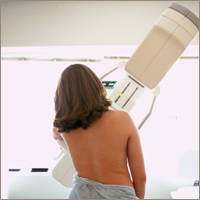
By David Richards, D.C., M.D.
Q: I just turned 40 and am worried about developing breast cancer. Do you suggest I get a mammogram?
A: There are two types of mammograms: a screening mammogram detects breast cancer in a woman who has no symptoms; a diagnostic mammogram evaluates a breast lump that has been detected by other means. My answer to your question specifically applies to screening mammograms in women at average risk for breast cancer. The term “average risk” means that you don’t have a known genetic mutation that predisposes to the development of breast cancer, and you don’t have a history of radiation to the chest for prior cancer. While having a family history of breast cancer in a first-degree relative (i.e., mother or sister) does make a woman more likely to develop breast cancer, the absolute increase in risk is not considered significant enough to influence the decision to do a mammogram.1
The purpose of a mammogram is to decrease the risk of dying from breast cancer. Based on evidence that there is a net benefit, national guidelines1 recommend that women between the ages of 50 and 74 who are at average risk for breast cancer obtain a mammogram every two years. However, the benefits of mammograms are small, and women should be made aware of this fact prior to obtaining the test. For example, in the case of a woman between the ages of 50-59 who gets a mammogram every one to two years for 10 years, she reduces her risk of dying from breast cancer by approximately 0.07 percent.2However, over those 10 years, she also has between a 5-20 percent chance of having a “false-positive” result on one of the mammograms.2,3 This means that the mammogram is suspicious for breast cancer, but there is really no cancer there. Besides the anxiety associated with the possibility of harboring breast cancer, this woman will be subjected to a biopsy that she doesn’t need.
A more concerning risk of mammograms is that of overdiagnosis, which refers to breast cancers detected that were never destined to cause symptoms or result in death. Because it is not possible to know which breast cancer diagnosis is “overdiagnosis,” all of these cancers are treated with surgery, chemotherapy, radiation, or some combination. The risk of overdiagnosis increases with age, and has been estimated to be between 0.1 and 0.7 percent.1,2,4
As is the case with all medical treatments and tests, each woman needs to decide for herself if the benefits of mammograms outweigh the risks. Women certainly do not need to feel guilty if they choose to forgo mammograms. On the other hand, if a woman has made up her mind that a mammogram is the right thing for her, I will fully support her decision as long as she has been educated about the limitations of this test.
References:
1. Screening for Breast Cancer, Topic Page. July 2010. U.S. Preventive Services Task Force.http://www.uspreventiveservicestaskforce.org/uspstf/uspsbrca.htm
2. The Benefits and Harms of Mammography Screening: Understanding the Trade-offs. Steven Woloshin, MD, MS; Lisa M. Schwartz, MD, MS JAMA. 2010;303(2):164-165. doi:10.1001/jama.2009.2007
3. GГёtsche PC, Nielsen M. Screening for breast cancer with mammography. Cochrane Database Syst Rev.2009;(4):CD001877
4. Mandelblatt JS, Cronin K, Bailey S, et al; Breast Cancer Working Group of the Cancer Intervention and Surveillance Modeling Network. Effects of mammography screening under different screening schedules: model estimates of potential benefits and harms. Ann Intern Med. 2009;151(10):738-747


 SUBSCRIBE TODAY AND NEVER MISS AN UPDATE
SUBSCRIBE TODAY AND NEVER MISS AN UPDATE